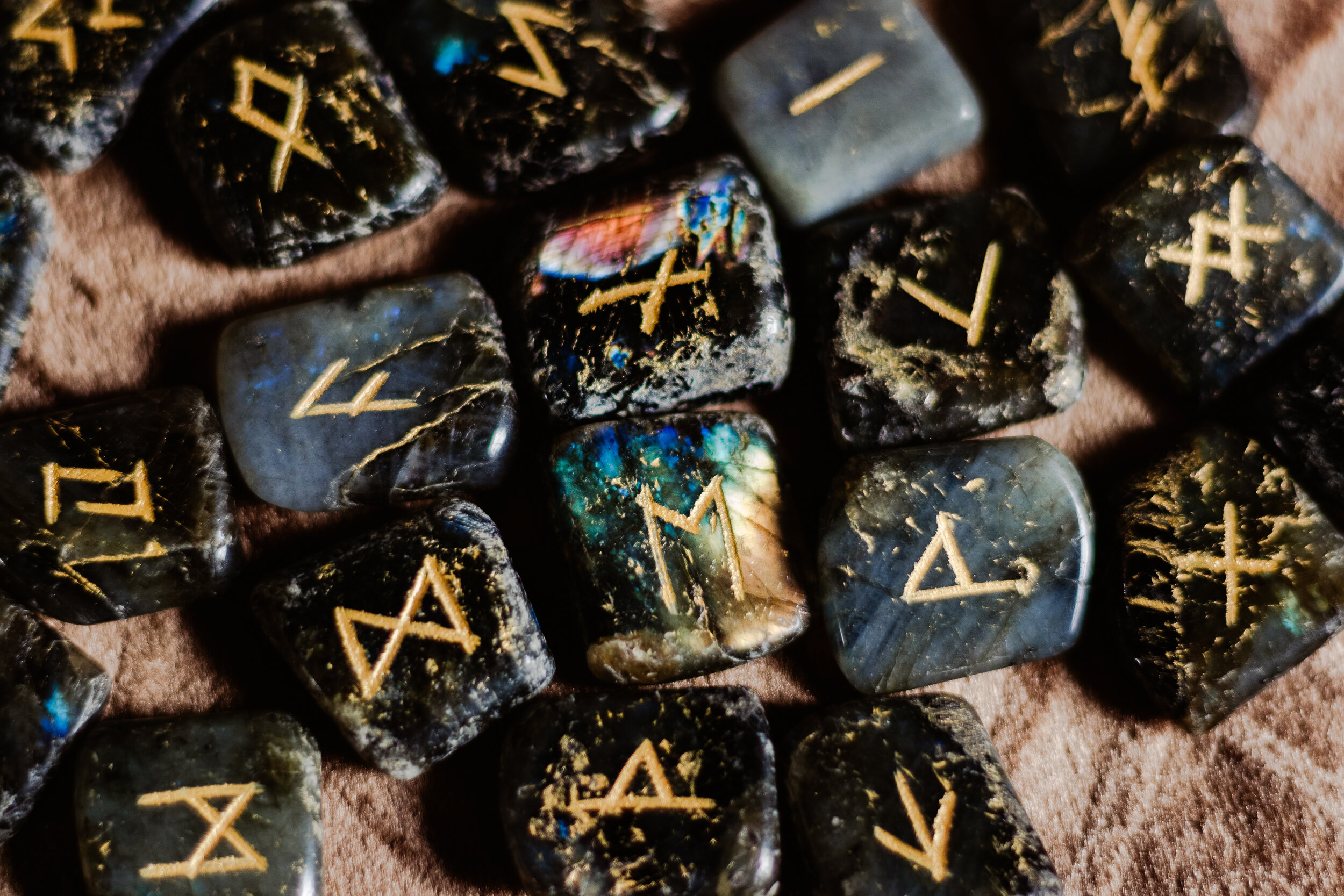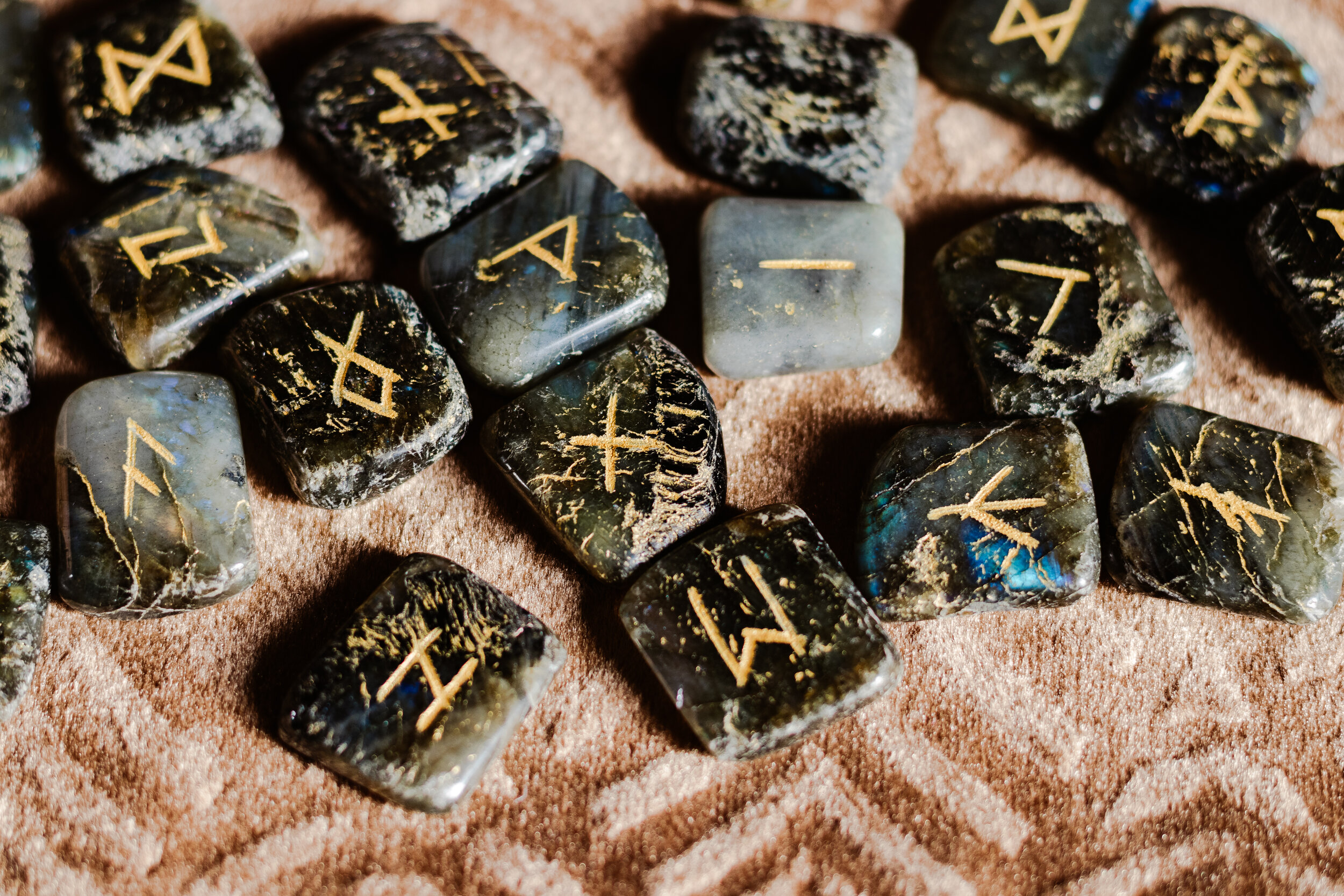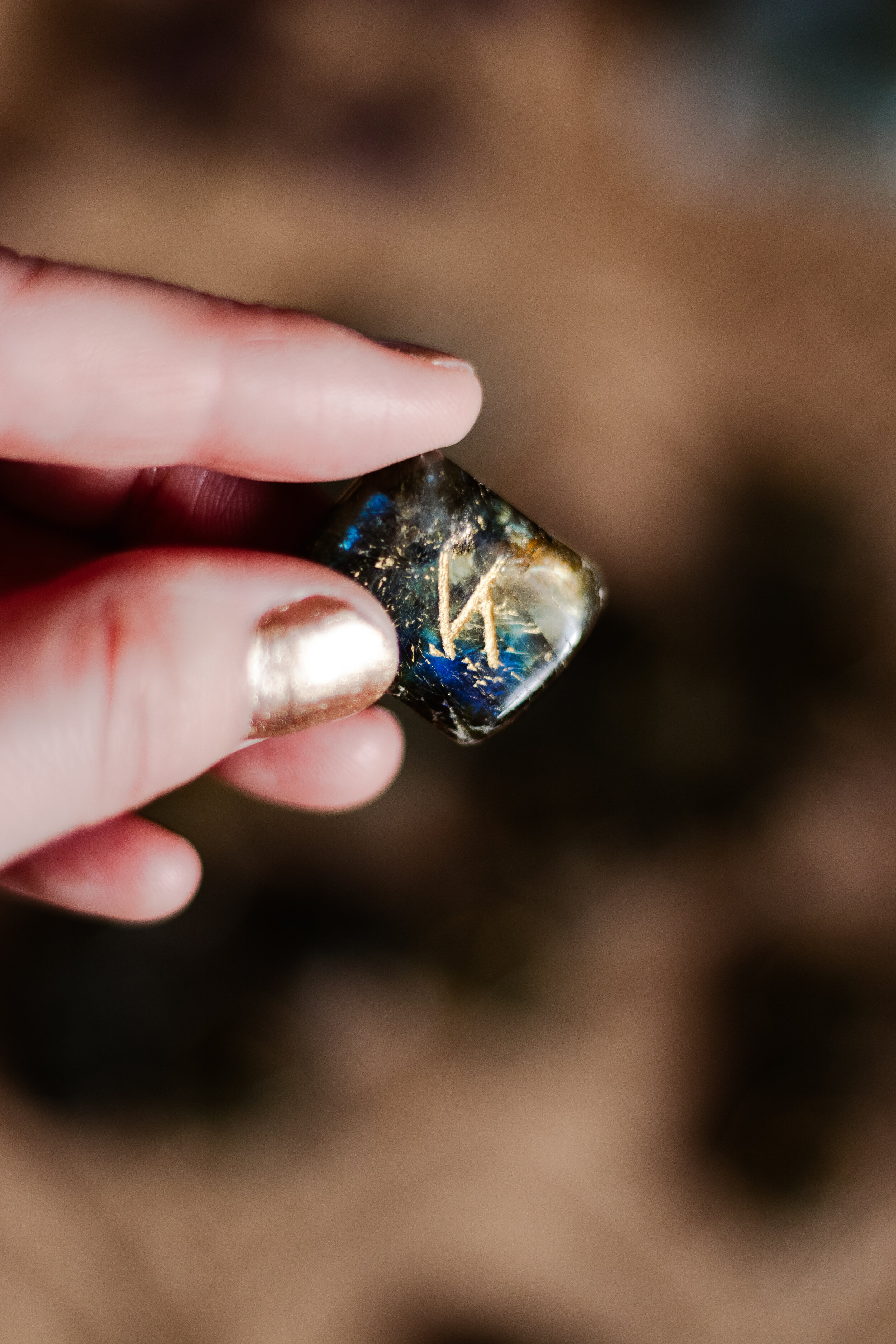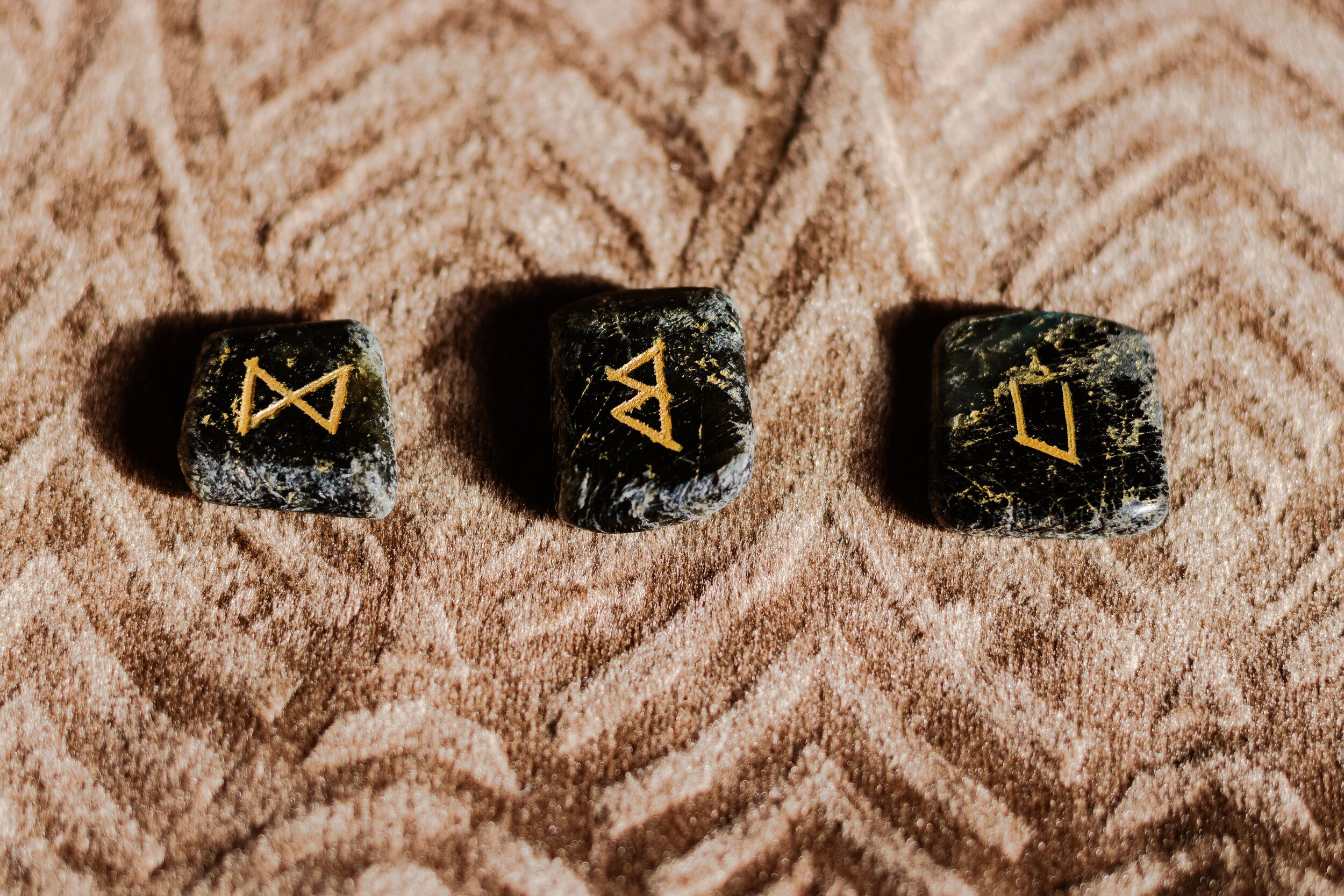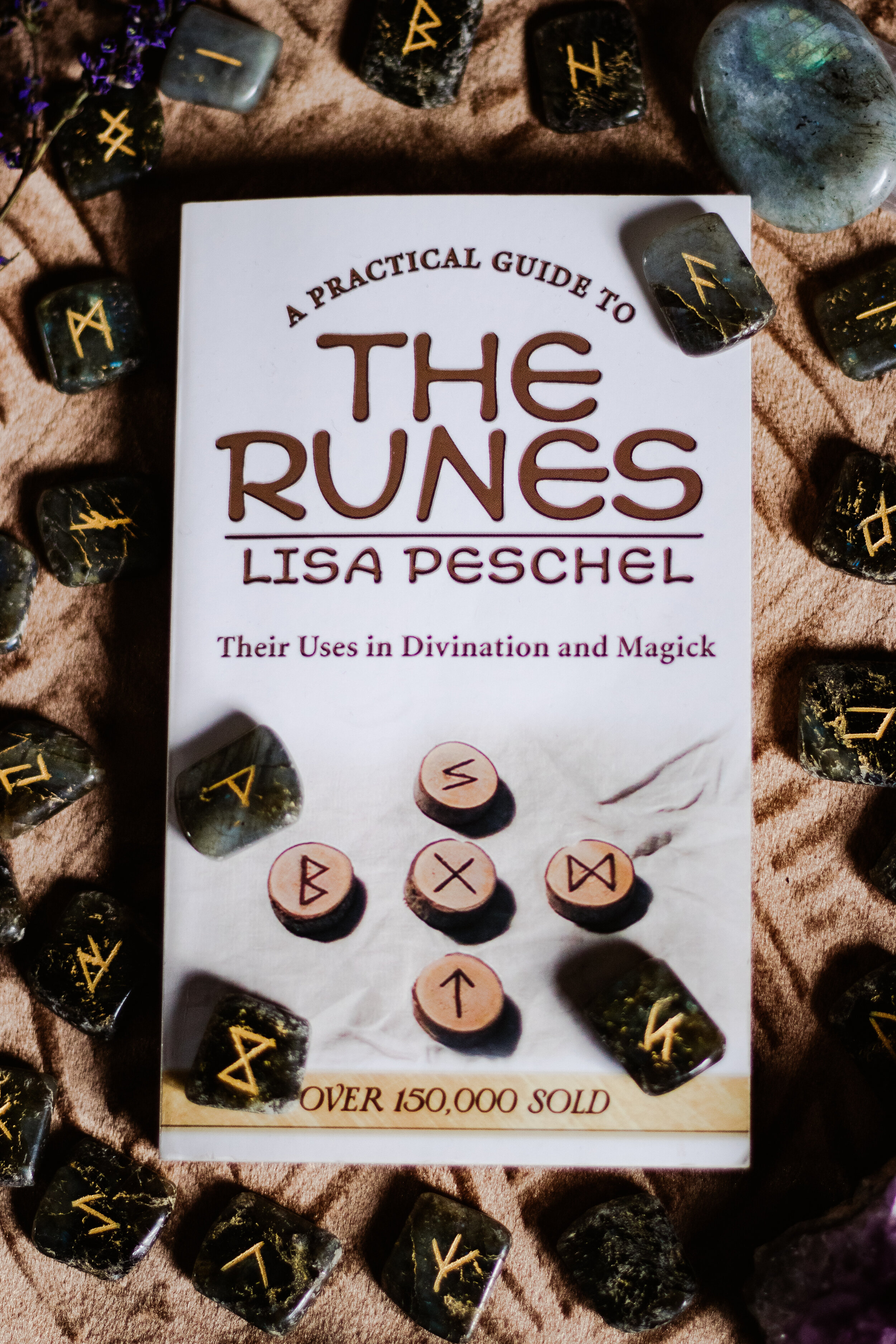What are Rune Stones? How To Use Casting for Divination (Part Two)
Hi everyone, welcome back to the blog! Thank you for joining me today to talk about casting rune stones. I hope that you find it helpful and consider subscribing if you haven’t already!
Last week I talked about using charms for divination, so this week I want to talk about another form of casting – using rune stones! If you’d like to know a little more about casting in particular, be sure to check out last week’s blog post and video on the topic. I hope you find it helpful too!
I’m so excited to talk about rune stones today – I absolutely love doing readings with them and learning about their history. So, get yourself a cuppa and we’ll dive right in!
~
What are Rune Stones?
Rune stones are essentially an ancient form of oracle cards, used by Germanic and Nordic tribes. Typically, there are 24 rune stones, each symbol representing a letter in the Elder Futhark alphabet. To see the full set, check out today’s video on YouTube.
As Lisa Peschel explains in her book, ‘A Practical Guide to the Runes’: “There were several different runic alphabets in use throughout Northern Europe over the centuries, but the most common is the Germanic or Elder FUTHARK. This alphabet received its name from its first six letters—F, U, TH, A, R and K. It was the system most widely in use between 200 B.C.E. and the late eight century and the one we shall be concerned with in this book. This alphabet contains 24 letters and is divided up into three groups of eight called Freya’s Eight, Hagall’s Eight, and Tir’s Eight.” (Peschel, L. ‘A Practical Guide to the Runes’. Linked Below).
To make life easier for myself and anyone else interested, I’ve created a free quick PDF guide to all the rune stone symbols in the Elder Futhark alphabet! If you’re already subscribed to my newsletter, you’ll find this waiting in your inbox already. To get your free copy, simply sign up for the newsletter at the bottom of this page. Plus you’ll also get a free guide to essential oils for focus - it’ll all be in your welcome email as soon as you sign up!
The newsletter features a weekly reading, lots of freebies, and so much more - I love sharing it each week, and hope to connect with you there!
I created the rune stone guide for myself as I’m still learning all the different symbols and meanings, and it’s been so handy!
For each rune stone, the guide also includes their equivalent letters in the English language, the Proto-Germanic, old English and old Norse names, along with a brief description and key words for each. I use this as a reference constantly while learning, as I’ve found that some sources can refer to certain rune stones by different names, which gets so confusing! For example, TIR is the Old English name, and TEIWAZ is the Proto-Germanic name, for the same rune stone. It’s interesting to see how the names changed over the centuries too! So hopefully you’ll find the guide really helpful – as I said, simply sign up below to get your free PDF copy!
~
Rune stones have been around for such a long time, and as I said in last week’s video about casting, it feels so wonderfully tactile and ancient. My rune stones are made of labradorite, one of my absolute favourite crystals, and honestly the energy of these stones is just beautiful! I’m planning to share a series on my Instagram where each week I talk about a different crystal, and next week will be about Labradorite so if that’s something you’re curious about, check out my Instagram @eboniehyland.
Traditionally, rune stones are made from wooden pieces. A tree branch is cut into rounds, then the symbol is etched onto the surface. They can also be created out of clay, any kind of stone, or even glass pebbles that you can find at a discount shop. You don’t have to search for a ready-made set online or at a shop, and you certainly don’t have to spend a fortune – you can simply make your own! I’d love to make a set one day too. But I admit… I fell head over heels for my labradorite set, on an online Australian crystal shop. I’ll link it down below if you’re curious! Not affiliated at all. I genuinely love my labradorite rune stones so much! I also know that if you’re currently still in lockdown like I am, here in Victoria, Australia, that it might be difficult to source a tree branch! If you want to get crafty still, but have to buy supplies online, you could try making rune stones out of clay.
If you’re interested in crystal rune stones and a bit unsure what to choose, try searching for your birth crystal or pick what you feel the most drawn to. Most importantly, make sure that the crystals have been ethically sourced.
Once you have your rune stones of course, you’ll want to know how to use them!
~
How to Use Rune Stones
In my experience so far, I’ve found there are three main ways to cast and read rune stones: one at a time, scattered or by following a layout of some kind.
Firstly though, it’s worth noting that when you’re using rune stones, or truly any form of divination, make sure that your question is specific, clear and proactive. For example, if you want a better job don’t ask: “When will I get a better job?” Instead ask: “How can I get a better job?”
When you’re using any divination method, you will get the best results when you ask for practical advice that can help you to improve your life.
That being said, here are three suggestions to read rune stones!
One Step/Stone at a Time
As I’m learning the rune stones, my go-to is often just drawing a single rune stone from the bag. I simply ask for general guidance, “What do I need to know right now?”
Once I draw the rune stone, I spend a moment really thinking about and connecting with that specific rune stone and how it might relate to my life at the moment. I check my quick reference notes, then look it up in ‘A Practical Guide to the Runes’ for more information. (I highly recommend this book if you’re interested in learning more about rune stones. I’ll link it down below too!)
I find this a really helpful practice that doesn’t overwhelm me, instead allowing me to focus on learning one rune at a time.
All at Once
More traditionally, the rune stones would be ‘cast’ or scattered on a white cloth. How the runes stones are displayed is an important element to reading them, and how each rune stone is interpreted depends on the others around it. While still learning of course, casting all 24 stones takes me ages to read and it’s so much information!
So if I feel like casting my rune stones, I typically take small handfuls at a time and scatter them. This way I still incorporate the wonderful energy of casting the rune stones, without using all the stones at once. It enables me to practice the connections between each of the stones, and how they scatter together, too. I highly recommend trying this method for yourself — just try to take your time with it!
Layouts
I’d imagine that following more of a layout method is perhaps a modern version of reading rune stones, but it’s a fantastic way to learn. Especially if you’re used to card reading and following different spreads. Don’t overcomplicate rune layouts, however. As Lisa Peschel writes, keep in mind that “the runes are a simple, earthy system and its layouts should also retain a bit of simplicity”.
Just as with card reading, there are layouts for every situation, or you can come up with your own. To give you an idea, I’d like to mention one of my favourite three rune layouts today. But I’ll definitely go more in depth on rune stones in the future so stay tuned for that if you’re curious!
~
The Three Rune Layout
First, hold your bag of rune stones in both hands, taking a moment to ask your question first. As I mentioned, make sure that your question is specific and clear. If you like, you can ask for guidance from any deities you believe in, or call on the Norns, Odin and Freya to aid you.
When you’re ready, ‘shuffle’ the rune stones in the bag, then pick three at random. Lay them out face down in front of you. Then turn them one at a time, as if turning the page of a book, so if any are reversed you aren’t flipping them right side up.
Rune #1: The first rune on the left indicates the problem.
Rune #2: The centre rune suggests what actions you should take regarding the problem.
Rune #3: The final third rune tells you what is likely to happen, but only if you follow the advice of the second rune stone.
Start with the first rune to really understand what the problem may be.
Then move to the second rune to understand what actions you may need to take. How does the second rune relate to the first? What is the second rune telling you to do about the problem at hand?
Finally, look to the third rune stone for the possible outcome – but know that there is no guarantee. The outcome presented to you by the third rune is not set in stone but is likely to happen if you follow the advice of the second rune in the layout. If you follow the second rune stone’s guidance, the result will be what the third rune indicates.
To see the three rune layout in action, watch today’s video here!
Hopefully the following example from ‘A Practical Guide to The Runes’ by Lisa Peschel helps you to understand how this three-rune method can be interpreted!
“Suppose you had OTHEL reversed in the first position, your second rune was FEHU upright and the final rune was ING, which indicates a fortunate outcome. The way these three runes would be read is this: OTHEL reversed tells me that you are out of money and are very worried about your financial status at present. FEHU signifies gain through hard work. If you follow FEHU’s advice and work extra hard to accumulate or save money, then you will get to ING, your fortunate outcome.
However, if you continue to merely mope about and do not take the advice of FEHU, then no matter how long you may wait, you will not have a fortunate outcome. In this case, you could not accuse the runes of playing you false. Through your own inaction you have evaded your good fortune, and you have no one to blame but yourself.
This example is yet another affirmation that the rune cast is an oracle to help you help yourself, rather than an absolute indicator of unchangeable future events.” (Peschel, L. ‘A Practical Guide to the Runes’)
Let me know if you try this layout for yourself! I find it a super helpful way when there’s a problem or issue on my mind. Sometimes the first rune stone will indicate an aspect to the issue at hand, that I haven’t even realised yet. Just as with any divination method, it always seems to tell me what I need to hear, whether I like it or not!
~
There is so much more to rune stones, especially in how they relate to one another, that I could make an endless number of videos on the subject and still only barely scratch the surface. I could talk for days about the history, the different meanings, and the magical correspondences and uses in manifestation. As I mentioned earlier, I would also love to try creating my own rune stones from scratch, using clay or a branch from a tree.
Like all forms of divination, the topic of casting is huge. There are as many varieties of casting as there are card decks, especially given the many unique ways that you can create your own form of casting, using whatever charms, sticks, stones, etc. that you have easy access to already. At the end of the day, divination always comes down to attributing meaning to objects, symbols, animals and all manner of things. Divination has played such an important role in history, as something that humans have done for centuries.
I believe divination lives on and is gaining in popularity because sometimes we just need a little guidance to direct our busy, modern minds. These tools, from Tarot to Rune Stones and everything in between, allow us to return to our intuition, our subconscious, the centre of our being, that is buried by distractions, worries and the ego.
To reference Lisa Peschel’s book on rune stones once more – when calling on rune stones for guidance, “The first thing you must remember is that you are consulting an oracle. You are not “having your fortune told.” The oracle is not an absolute . . . (It) gives you the information and allows you to decide what to make of it. The answers to be found in the runes are the ones to be found in yourself. Seek them, and listen with your inner ear.”
In my opinion, rune stones can be difficult to read – but with time and patience, I hope to learn as much as I can about this beautiful, ancient oracle.
I’d love to know your experiences with rune stones, or any form of casting! Let me know, have you tried casting rune stones before? If not, would you like to try them for yourself?
~
I hope that you found today’s video on rune stones helpful, and that it answered your questions! If you’d like to learn more, be sure to comment down below or follow me on Instagram @eboniehyland. Also don’t forget to sign up for the newsletter below for your free PDF quick guide to rune stones. I use it every day while I’m still learning, so I hope you find it helpful to learn rune stones too!
If you haven’t already please consider subscribing to the YouTube channel too, it really does mean the world to me! And ring the little bell to be notified when I post, every Thursday. I’m seriously loving creating videos and writing these blogs, and hope to use these platforms as a way to connect with like-minded people. If you’re interested in things like rune stones too, I hope you’ll join me in this little corner of the internet!
Thank you so much for being here! I hope you’re doing well, wherever you are in the world.
Until next week,
Ebonie xx
Resources and Recommendations
✧ ‘A Practical Guide To The Runes’ by Lisa Peschel. Available from: Amazon
✧ Labradorite Rune Stones. Available from: Aus Crystals
✧ ‘Quick Guide to Rune Stones’ - Access your FREE PDF guide by subscribing to the weekly newsletter! If you haven’t already, simply fill out the form at the very bottom of this page, and it’ll be in your inbox straightaway!
✧ ‘Rune stones, the basics and how to use them || Enchanted Endeavours Ep. 4’ YouTube Video by Harmony Nice. Really great intro video, with another simple 3 rune layout you can try!


